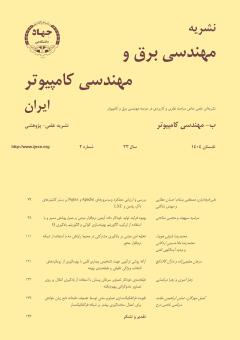تخلیه امن مبتنی بر یادگیری مشارکتی در محیط رایانش مه با استفاده از شبکه نرمافزار محور
محورهای موضوعی : مهندسی برق و کامپیوترمحمدرضا شرفی هویدا 1 , محمد رضا ملاحسینی 2 , وحید آیت الهی تفتی 3
1 - گروه مهندسی کامپیوتر، واحد میبد، دانشگاه آزاد اسلامی، میبد، ایران
2 - گروه مهندسی کامپیوتر، واحد میبد، دانشگاه آزاد اسلامی، میبد، ایران
3 - گروه کامپیوتر، واحد تفت، دانشگاه آزاد اسلامی، تفت، ایران
کلید واژه: شبکه نرمافزار محور, یادگیری مشارکتی, محاسبات مه, اینترنت اشیاء.,
چکیده مقاله :
در اینترنت اشیا به دلیل حجم بالای دادهها، چالشهای قابل توجهی در پردازش و ذخیرهسازی اطلاعات هست که نیاز به توجه دارد؛ از جمله تأخیر، آگاهی از مکان و پشتیبانی از تحرک در زمان واقعی. محاسبات مه به عنوان یک راهکار مؤثر برای این چالشها شناخته میشود. این مقاله به بررسی روشهای مختلف تخلیه امن مبتنی بر یادگیری مشارکتی در محیط رایانش مه با استفاده از شبکه نرمافزارمحور میپردازد و چهار روش بهینهسازی شامل SDN، SA+GA، OLB-LBMM و Round-Robin را مورد تحلیل و مقایسه قرار میدهد. هدف اصلی این تحقیق، بهبود عملکرد و امنیت در فرایند تخلیه دادهها با توجه به چالشهای موجود است. روش شبکه نرمافزارمحور به عنوان یک چارچوب منعطف برای مدیریت منابع و دادهها در شبکههای اینترنت اشیا، عملکرد بهتری نسبت به سایر روشها ارائه میدهد و با کاهش تأخیر و بهینهسازی تخصیص منابع، موجب افزایش رضایت کاربران و درآمد ارائهدهندگان خدمات ابری میشود. همچنین الگوریتمهای SA+GA و OLB-LBMM بهبودهایی در کارایی و امنیت ارائه میدهند، اما با چالشهایی در تأخیر و پیچیدگی محاسباتی
مواجه هستند. نتایج نشان میدهند که یادگیری مشارکتی در ترکیب با شبکه نرمافزارمحور میتواند بهبود قابل توجهی در تخلیه امن دادهها و مدیریت منابع شبکه ایجاد کند.
The Internet of Things poses significant challenges in data processing and storage due to the large volume of data generated, including latency, location awareness, and real-time mobility support. Edge computing is recognized as an effective solution to these challenges. This paper examines various secure offloading methods based on collaborative learning in edge computing environments using software-defined networking and analyzes four optimization methods: SDN, SA+GA, OLB-LBMM, and Round-Robin. The main objective of this research is to improve performance and security in the data offloading process while addressing existing challenges. The SDN method provides a flexible framework for managing resources and data in IoT networks, demonstrating better performance than other methods. By reducing latency and optimizing resource allocation, it enhances user satisfaction and increases revenue for cloud service providers. Additionally, the SA+GA and OLB-LBMM algorithms offer improvements in efficiency and security, although they face challenges related to latency and computational complexity. The results indicate that collaborative learning combined with SDN can significantly enhance secure data offloading and enable dynamic network resource management. This research can serve as a foundation for future studies aimed at optimizing data offloading processes in edge computing environments.


